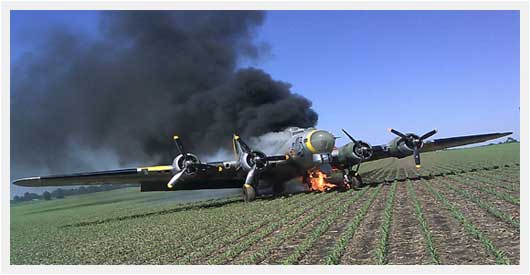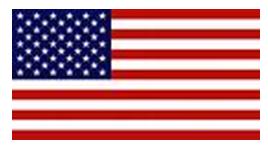Liberty Belle B-17 Fire: Statement From Liberty Foundation Chief Pilot
 Wednesday, June 15, 2011 at 07:20PM
Wednesday, June 15, 2011 at 07:20PM  Liberty Belle B-17 shortly after forced landing on Monday June 13, 2010
Liberty Belle B-17 shortly after forced landing on Monday June 13, 2010
My post from Monday on the fire that essentially destroyed the Liberty Belle B-17 shares the details on how I was scheduled to be on the very next flight out of Indianapolis Regional Airport.
This post is a lengthy and very informative explanation of the incident from the Chief Pilot for the Liberty Foundation, Ray Fowler. Fortunately everyone onboard was unharmed, and it's always great to get the details from people who really know what happened...
Statement from Liberty Foundation Chief Pilot:
June 14, 2011 - First, let me start off by sincerely thanking everyone for the outpouring of support that we are receiving. I am sorry that I have not yet had the opportunity to return the many phone calls, text or e-mails that I am receiving offering to help. Again, thank you for all of the kind words that we are receiving and for incredible offers to help emotionally, financially and/or with the recovery process. I hope this statement will help fill in a few details that everyone is wondering about that led to the loss of our “Liberty Belle”.
Yesterday (June 13, 2011) morning, both our P-40 and B-17 were scheduled to fly from Aurora, Illinois to Indianapolis, Indiana. We were in Aurora for the weekend as a part of our scheduled tour. Over the course of the previous week, we completed a scheduled 25-hour inspection on the B-17 which was completed by Saturday. On Saturday, the weather stayed below the required ceiling to give any passenger flights, however the B-17 flew in the morning on a routine training proficiency flight, performing several patterns. Following the flight, other maintenance issues arose that required us to cancel our Sunday flying schedule for repairs. The maintenance performed has not been, in any way, associated to the chain of events that led to Monday’s fateful flight, but is being considered in the preliminary investigation. However, due to the media’s sensational (mis)reporting, there is a large amount of misinformation that continues to lead the news.
Here is what we do know… Flying in the left seat of the B-17 was Capt. John Hess. John has been flying our Liberty Belle since 2005 and one of our most experienced B-17 pilots. He is an active Delta Air Lines Captain with over 14,000 hours of flying experience and flys a variety of vintage WWII aircraft. In the right seat was Bud Sittic. While Bud is new to the Liberty Foundation this year, he is also incredibly experienced with over 14,000 hours of flying time in vintage and hi-performance aircraft. He is a retired Captain with Delta Air Lines.
The news misidentified the P-40 as flying chase during the accident. I was flying our P-40, however I had departed 20 minutes prior to the B-17’s takeoff on the short flight to Indianapolis to setup for the B-17’s arrival. The aircraft flying chase was a T-6 Texan flown by owner Cullen Underwood. Cullen is one of our rated B-17 Captains and an experienced aviator tagging along as a support ship.
The takeoff of both aircraft was uneventful and proceeded on-course southeast. Prior to exiting Aurora’s airport traffic area, the B-17 crew and passengers began investigating an acrid smell and started a turn back to the airport. Almost immediately thereafter, Cullen spotted flames coming from the left wing and reported over the radio that they were on fire.
As all pilots know, there are few emergency situations that are more critical than having an in-flight fire. While an in-flight fire is extremely rare, it can (and sometimes does) indiscriminately affect aircraft of any age or type. In-flight fires have led to the loss of not only aircraft, but often can result in catastrophic loss of life. It requires an immediate action on the flight crew, as the integrity of aircraft structure, systems and critical components are in question.
Directly below the B-17 was a farmer’s field and the decision was made to land immediately. Approximately 1 minute and 40 seconds from the radio report of the fire, the B-17 was down safely on the field. Within that 1:40 time frame, the crew shutdown and feathered the number 2 engine, activated the engine’s fire suppression system, lowered the landing gear and performed an on-speed landing. Bringing the B-17 to a quick stop, the crew and passengers quickly and safely exited the aircraft. Overhead in the T-6, Cullen professionally coordinated and directed the firefighting equipment which was dispatched by Aurora Tower to the landing location.
Unlike the sensational photos that you have all seen of the completely burned B-17 on the news, you will see from photos taken by our crew that our Liberty Belle was undamaged by the forced landing and at the time of landing, the wing fire damage was relatively small. The crew actually unloaded bags, then had the horrible task of watching the aircraft slowly burn while waiting for the fire trucks to arrive. There were high hopes that the fire would be extinguished quickly and the damage would be repairable. Those hopes were diminished as the fire trucks deemed the field too soft to cross due to the area’s recent rainfall. So while standing by our burning B-17 and watching the fire trucks parked at the field’s edge, they sadly watched the wing fire spread to the aircraft’s fuel cells and of course, you all have seen the end result. There is no doubt that had the fire equipment been able to reach our aircraft, the fire would have been quickly extinguished and our Liberty Belle would have been repaired to continue her worthwhile mission.
Let me go on the record by thanking the flight crew for their professionalism. Their actions were nothing short of heroic and their quick thinking, actions and experience led to a “successful” outcome to this serious in-flight emergency. John and Bud (and Cullen) did a remarkable job under extreme circumstances and performed spectacularly. While the leading news stories have repeatedly reported the “crash” of our B-17, fact is they made a successful forced landing and the aircraft was ultimately consumed by fire. Airplanes are replaceable but people are not and while the aircraft’s loss is tragic, it was a successful result.
This leads me into discussing the exceptional safety record of the Boeing B-17 and to hopefully squash the naysayers who preach we should not be flying these types of aircraft. Since we first flew the “Liberty Belle” in December of 2004, we have flown over 20,000 passengers throughout the country and if you count our historic trip to Europe in 2008, worldwide. Of the other touring B-17s, some of which that have been touring for over 20 years, they have safely flown hundreds of thousands of people. The aircraft’s safety record is spectacular and I am certain the overall cause of our issue, which is under investigation, will not tarnish that safety record. In fact, as many of you know, other B-17 have suffered significant damage (although not as bad as ours!), only to be re-built to fly again. From a passenger carrying standpoint, I can think of few aircraft that offer the same level of safety as the 4-engine “Flying Fortress”. As mentioned earlier, in-flight fires are extremely rare and certainly could affect any powered aircraft under certain circumstances. I would put my children today in any of the other touring B-17s to go fly. I suggest to anyone that was thinking of doing so when a B-17 visits your area to do so without giving our loss any thought.
There is wild speculation going on as to the cause of our fire and the affect to other operators. Please let the investigation run its course and report the findings. The NTSB and FAA were quickly on the scene and we are working closely with them to aid in the investigation. As soon as we receive some additional information, we will release it via the website.
The ultimate question remains, where does the Liberty Foundation go from here? After the investigation and recovery, we will determine our options. We are still committed to the restoration and flying of World War II aircraft. Again, we appreciate the support and people offering to help get us back flying.
Please check back for updates. I will close by thanking everyone that made our tour so successful. From the first day of the B-17’s restoration, thank you for all of you who labored to get her flying over the initial restoration years and to everyone that has worked on her out on tour since. Thank you to the crewmembers, tour coordinators and volunteers who gave up weekends and countless hours to support her on the road. And finally, thank you to the passengers, donors and media patrons that flew aboard and everyone who supported our cause. Hopefully, this will not be the end of the story, but a new beginning.
Regards,
Ray Fowler
The Liberty Foundation, Chief Pilot
 Martt |
Martt |  Post a Comment |
Post a Comment | 













































































Reader Comments